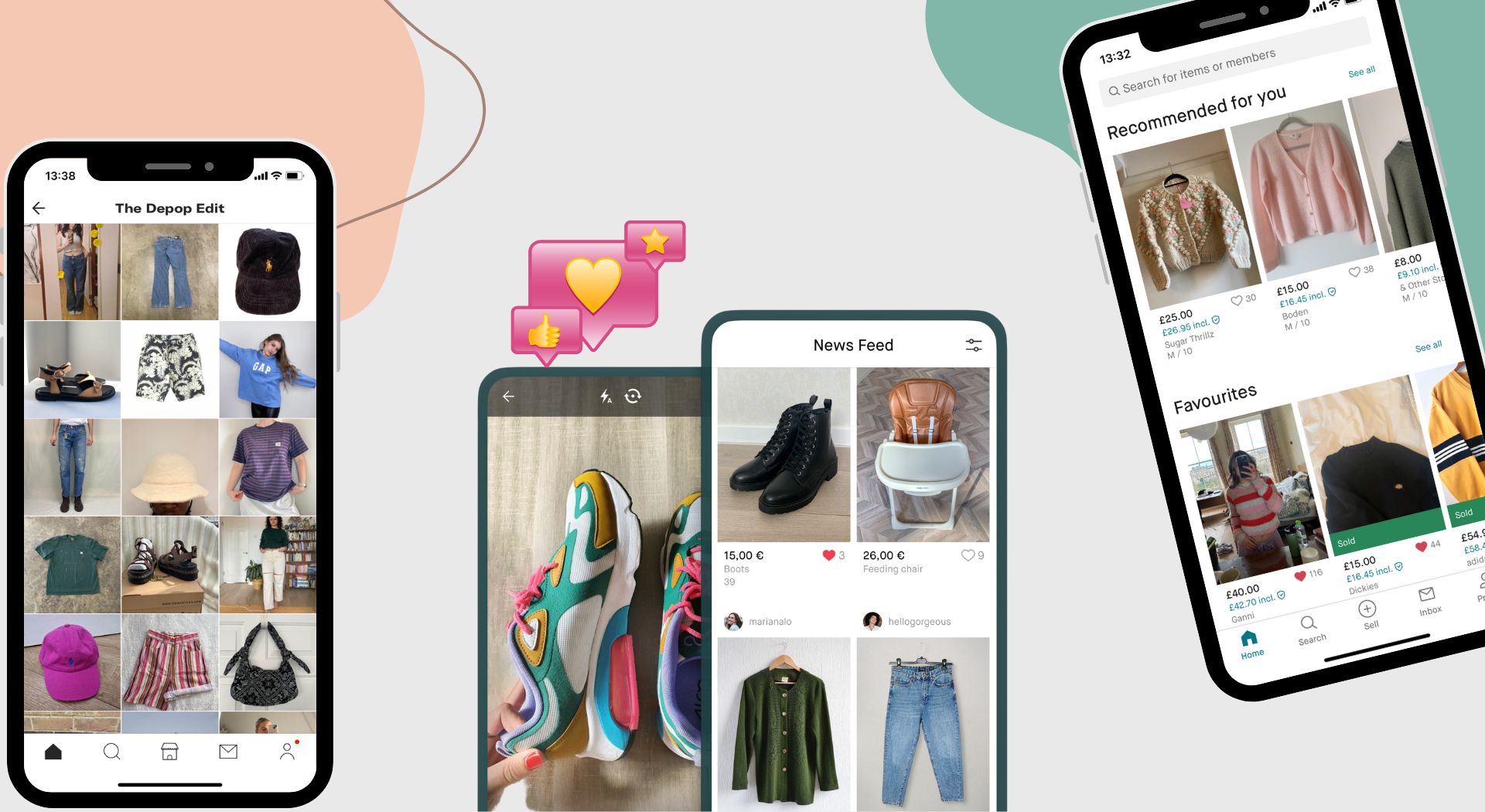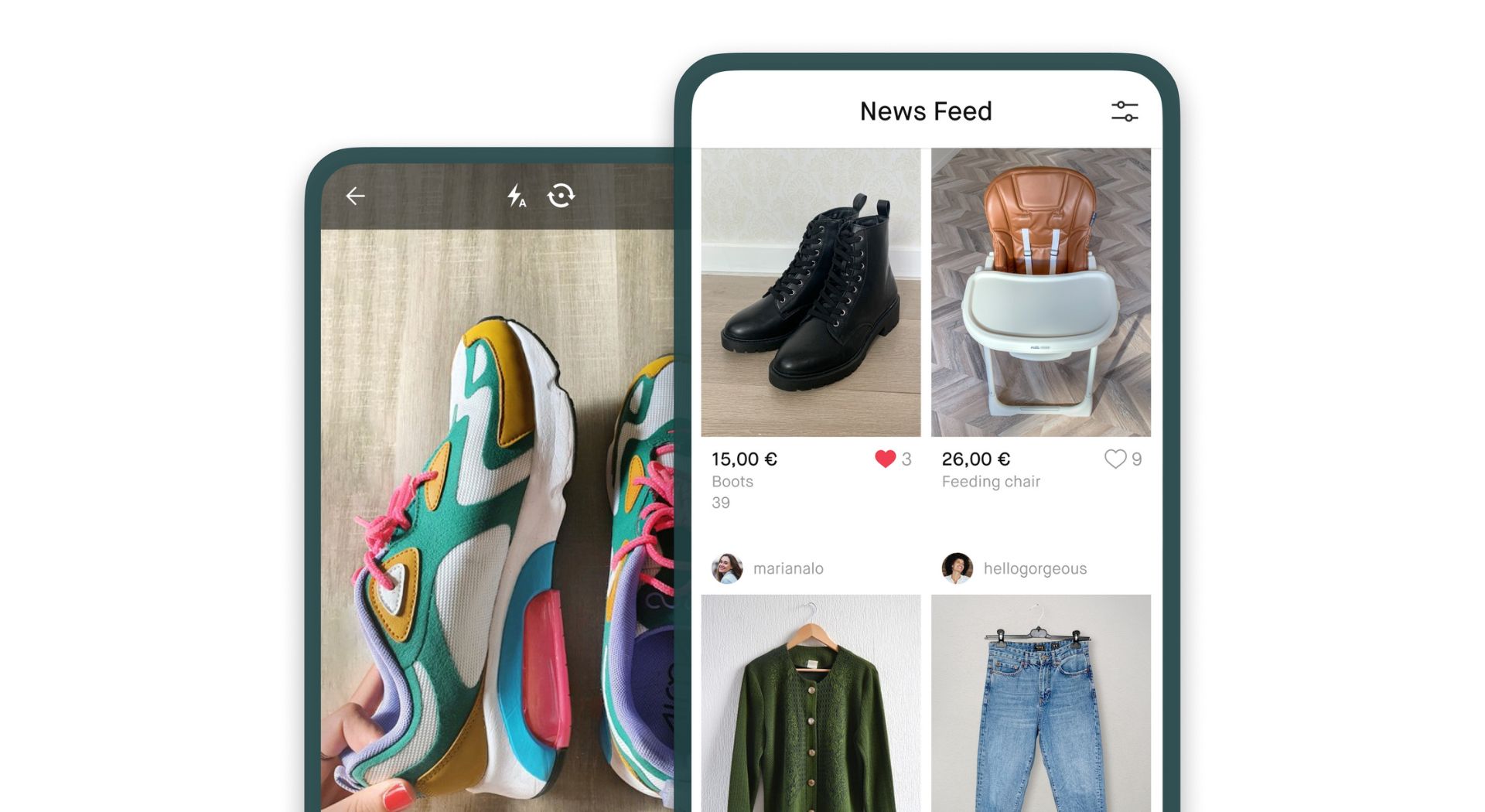How to sell clothes online: everything you need to know about selling your old clothes
To learn how to sell clothes online we spoke to experts and put their advice to the test ourselves to bring you this comprehensive guide full of top tips


Harriet Davey
Knowing how to sell clothes online can not only help you declutter but it can help you make money too. While there are lots of different sites and apps that you can successfully sell items on, it can be hard to decipher which is the best (and safest), so we spoke to experts and tried selling clothes online ourselves to find out.
Selling your clothes online has never been easier, so if you're thinking about how to declutter your home and have found yourself with a growing pile of clothes that no longer feel like 'you', there are lots of ways to make money from them. Plus, for those wondering how to shop sustainably, you'll be promoting slow fashion and shopping secondhand, ensuring your preloved clothes can have a new lease of life in someone else's closet.
The main tip for beginners would be to approach reselling as a decluttering exercise. See it as the perfect opportunity to go through your closet, ask yourself what you still use and like (be honest and harsh with yourself.) The stuff that no longer gives you pleasure like it once did should be sold. When you resell you can then continue to update your style and capsule wardrobe with a good conscience.
Use our guide to the best apps to sell clothes online to find the site or platform that's right for you, then start taking pictures of your garments and uploading them to the app for people to browse.
Hannah Shapiro, owner of Depop and ASOS Marketplace shop Shapiro Selective, notes that it’s important to be realistic, “don’t expect everything to sell straight away!” and Rachel Karasik, top seller and owner of Poshmark shop @huntandsage suggests you "start slow with a few items" and see how much interest they get before uploading your entire closet onto a clothes resell site.
How to choose where to sell clothes online
We spoke to top sellers and insiders at preloved shopping platforms such as Poshmark, Vinted and Depop, to find out the best places to start selling clothes online and all of our experts suggested considering the target audience of a certain platform, and thinking about whether the people who use the platform would be interested in your clothes.
Emily London, vintage fashion seller and secondhand stylist, explains that “choosing where to sell your clothes online should be based on the type of clothes you have to sell. If you have a lot of plain white t-shirts, for example, I wouldn’t suggest selling them on eBay, as there are thousands of similar listings. But if you have a very specific item for sale, like a designer handbag or vintage dress, listing on eBay is a good way forward, as unique items tend to attract devoted buyers.”
Sign up to our free daily email for the latest royal and entertainment news, interesting opinion, expert advice on styling and beauty trends, and no-nonsense guides to the health and wellness questions you want answered.
Poshmark top seller Rachel Karasik adds that "when choosing which platform to sell on, my advice is to be realistic and do your research. eBay is known to reach an insanely wide audience, but for me personally, it’s too complicated a platform in regards to shipping procedures."
Crystal Blandshaw, top seller and owner of Poshmark shop @fashion_deity, also suggests some factors to consider when choosing a platform, including the "fees, target audience, ease of use, customizability, and whether the platform offers customer support, resources and tools to help you succeed."
Lots of sellers - including several of the experts we spoke to - list items across several different platforms, although the pricing, shipping costs and item descriptions might vary depending on which site they’re listed on.
Shapiro tells us that the best way to go about finding a platform to sell on might be to experiment: "List a couple of items on each platform and see if they sell, and work out if you enjoy using the app" because if you find the app tricky to use, there's others to choose from you might prefer instead.
These are the best places to sell clothes online at a glance:
- Vinted - best for people who are new to selling clothes online as it's simple to use, best for making a profit (it's completely free to list and sell on) and selling multiple items with bundles
- Depop- best for building a following, selling vintage clothing and accessories, and finding a niche as a seller to make a profit
- eBay - best for reaching a large audience, listing tech items and larger products and selling safely
- Poshmark - best for finding a community, having fun with listings, and using a simple interface
- ASOS Marketplace - best for building a side hustle and being rewarded for consistency
You can also check out our detailed guide to the best apps to sell clothes online in 2023 for more information.
What to consider when choosing a platform to sell your clothes online
There are great resell opportunities at all prices points, but choosing the right platform is key to your success. You want to make sure you do a really deep dive into the platform and see what other brands and price points are selling on the site to make sure it matches the clothes you have to sell.
If you're looking to sell any of the best designer bags, such as any of the best Gucci bags you want to make sure you select a platform that deals in luxury goods. Shoppers are often nervous about buying second-hand designer items online, but many of the luxury platforms offer an authenticity service and a number will do the hard work of selling it for you too. It's a win/win all round.
You should also consider how easy you find it to use the platform. If you find the process of listing your clothes laborious and difficult then it's going to put you off using the platform regularly. A secret to how to sell clothes online is to list items frequently so you have a steady stream of garments listed on your profile for potential buyers. This will be easier to keep up if you find the platform you're selling on simple to navigate.
Advice for selling clothes safely online
It’s natural to be concerned about the safety of selling your preloved items or clothes online, but as long as you choose a reputable platform, the chances are the app or website will have terms and conditions in place to protect both buyers and sellers.
Emily London tells us that "in recent years, all online selling platforms have increased their efforts to keep both sellers and buyers safe from scams." She adds, "when I’m liaising with a potential buyer on eBay, I look at their feedback ratings to see if there are any red flags I should be aware of. It’s important to make yourself aware of the site’s policy about selling, too, so you can understand what your rights are."
While most platforms will be safe to sell and buy clothes on, it’s still important to look out for dodgy selling practices, such as a buyer offering to pay via Paypal to avoid fees - always choose the payment method provided by the platform, so that your transactions are protected and you can access customer service if needed. Blandshaw advises, "always ensuring your safety by making sure users follow best practices, such as communicating with buyers and sellers through the platform only, shipping with the provided tracking label, and carefully reviewing each transaction before accepting."
Shapiro advises always taking payment through the app or website's official payment methods - never let a buyer message you privately and arrange a different way to pay. In their experience "scammers sometimes ask you to pay externally through PayPal or Cashapp."

Is selling clothes online profitable?
All of our experts agreed that selling clothes online can indeed be profitable, as long as you have a clear understanding of how much your items are worth. Plus, make sure you know how much postage might cost you and you are consistent with building your profile. Always ensure you are communicative and friendly to buyers and potential buyers too, because this in turn will secure positive reviews and future sales.
Emily London tells us that "it’s important to educate yourself on the prices of different items and brands within the reselling world. Knowledge is power! The more you learn, the better you become at deciding on an item’s worth and the price you can sell it at." London advises that new sellers take into account the time and effort that will be spent on photographing, listing, packaging and posting items too, as spending money on things like padded envelopes can really "eat into profit margins".
Poshmark top seller Crystal Blandshaw says that "selling clothes online can be highly profitable when you have a solid strategy in place," but encourages sellers to "carefully source your inventory, price your items competitively, and market your closet effectively. Keep in mind that there are costs involved, such as listing and transaction fees, shipping and packaging materials, but these costs should be factored into your final price."
Shapiro agrees, adding that "you need to make sure you’re setting the right shipping costs, paying attention to taxes (especially internationally), and looking after your profit. If you include any free gifts or special packaging, you need to keep track of that too - they can run away a lot faster than you might expect!"
What are the secrets to ensuring your clothes sell fast online?
1. Take great photographs
The most common piece of advice our experts gave to first time sellers is to take clear, well-lit photos of a high quality. This is the first thing a potential buyer will see, and the quality of the photo will likely play a big part in their decision whether to buy. Natacha Blanchard, Consumer Lead at Vinted, says “it’s important to help potential buyers have an accurate idea of the items they’re buying, and pictures are the best way to show this, so take photos from lots of different angles. Even if you think it’s repetitive, the buyer will appreciate it!”
Emily London suggests “shooting items in natural daylight, so the true color of the piece really comes through in pictures.” While the photos in your listings should make the items look as attractive as possible, it’s important to take ‘honest’ photos, too; a few of our experts recommend photographing any flaws in pieces, such as a small hole or stain, and being honest about this in the caption for full transparency.
The number of photos you add is also important. Founder and CEO of preloved fashion site By Rotation, Eshita Kabra-Davies, tells us that “to make the most out of your listings, upload at least four photos of the item and write a clear description."
2. Spend time on your captions
After the photos you add, the caption is probably the second most important factor of selling clothes quickly. Think of all the questions you may get asked e.g. size, fit, material, if it’s coming from a smoke and pet-free home, and answer them all in the description. It’ll save you time in the long run.
Blanchard tells us that "instead of using a generic ‘I don’t need it’ statement in the description, you can elevate your item and make it more memorable by simply sharing a story about it. It’s a great way for the buyer to feel even more excited about discovering it and importantly, kickstarts a connection with the new potential buyer and your item." A caption should be informative, tell a story, and give the potential buyer as much detail as possible, to inform their purchase.
Depop’s spokesperson agrees, adding that you should consider “relevant keywords and stand-out features and try to include as much detail as possible in the description, as this will help your items show up in searches."
While the clothes you’re selling don’t need to be in incredible condition - a spokesperson from Depop reminds us, “nobody expects preloved items to be perfect!” - it is important to be completely honest about the piece’s condition, as with the pictures you use. Make sure you’re transparent about what you’re selling. If the item has any faults or marks, be honest about it. It’ll save you time dealing with any complaints.
“Make sure to document any flaws the item might have, so the buyer can feel confident about the purchase”, says London.
3. Price items accordingly and offer discounts
Whether you’re selling clothes on Depop, Vinted, eBay, Poshmark or any other platform, it’s always a good idea to search for the item you’re selling and see what other sellers have priced it at. Search the platform you choose to sell on for similar pieces to see how much other sellers have listed them for. Sites such as eBay allow you to filter by 'sold' items so you can see how much similar items have sold for.
"After searching for similar items and seeing the average selling price, you can then position yourself competitively, depending on factors such as the brand and item condition," says Blanchard. Lots of our experts agreed, telling us that competitive pricing is one of the best ways to pique potential buyers’ interest and get your items noticed quickly.
Another way to build up a substantial selling profile and start selling fast is to lower the prices of your items: Blandshaw advises sellers to "consider running sales or offering discounts to incentivize buyers."
Platforms like Vinted and Depop allow buyers to make offers on items they’re interested in - something that I tried every time someone favourited my items on Vinted - so it’s worth considering the lowest offer you will accept on an item, or haggling with potential buyers to reach a fair price.
You can also try seasonal sales on your items. Think about what people may be buying at particular times of the year. For example, you're more likely to sell sweaters in pre-fall and trending sunglasses before or during summer.

4. Know your brands
Take time over your listing and always proofread your caption. Misspelling a brand will mean fewer people see it.
Also, make sure you know what you're selling and how much its original price would be. Knowing your labels can help determine which platform to sell items on and high-end/luxury pieces that retain their value are likely to sell better than unknown of less-er known labels, for example, an iconic piece like a Burberry trench coat, will always be in demand as it is a classic. If you have lower price point pieces to get rid of, Gumtree and Preloved are good places to try out.
5. Don't be afraid to try different things
If you’re at the beginning of your selling journey and you’re not sure what your target audience is yet, or how to build up your seller profile, have fun and experiment with different techniques. Hannah Shapiro tells us that "different things will work for different people, so have patience and don’t be afraid to try new things. If your items aren’t selling, think about retaking the photos or changing the description or trying a different platform. Don’t give up!"
Final top tips for how to sell your clothes online from our experts
- Always post on time: If you’ve outlined when you’ll send the item or when the buyer will receive it, stick to this. Unless, of course, it can’t be helped due to delays.
- Communicate: Be quick at replying to questions or potential buyers, if you waste their time you may lose a potential sale.
- Research what you can and can't sell: Each platform is different, so make sure you check which type of products are listed. For example, Vinted won't let you sell certain electrical items on their platform, but you can sell these on sites like eBay. For items such as lingerie or swimwear, this is best to only sell if new due to hygiene reasons. Instead, donate to a clothes bank which will responsibly recycle these as a textile.
- Package your pieces correctly: There's nothing worse than buying something online secondhand for it to turn up damaged. Make sure you use protective packaging and opt for biodegradable or recyclable iterations if possible. The buyer will mostly pay for P&P but this can be discussed with your potential buyer, but make sure you check the weight and size of your package and find out the price it will be online so you don't lose money having to cover these extra costs.
- Check the commission costs: To make the most money from selling your old clothes, it's best to check how much commission each platform will take from each sale you make before listing items.

Hannah is the UK Shopping Writer for woman&home. As a shopping writer, Hannah has written on everything from period pants to wine subscriptions, and is especially interested in sustainable alternatives to well-known products, as well as books and homeware accessories.
Before she joined the team at woman&home Hannah headed up the social media accounts for Wonderland in 2019, where she was also a Contributing Editor for the magazine’s sister titles. During the COVID-19 pandemic, Hannah also explored evolving shopping trends at New York Magazine’s The Strategist UK, researching everything from face masks to status candles and even pens.